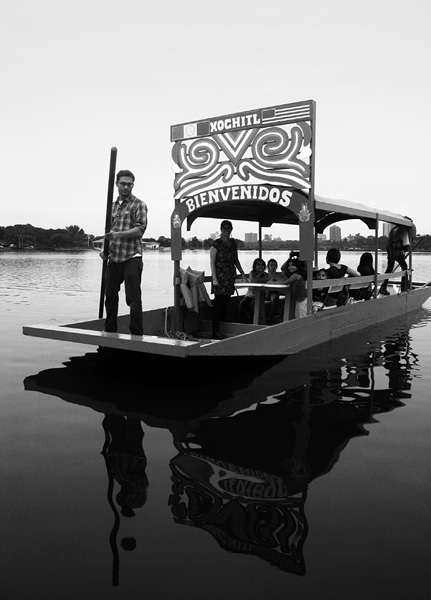
TRAJINERA XOCHITL
first performed on
August 7, 2011
Louis Valentino, Jr. Park and Pier, Brooklyn, NY
performed twice in 2011
NATALIA PORTER
New York, NY
532627418n532627418a532627418t532627418a532627418l532627418i532627418a532627418.532627418p532627418o532627418r532627418t532627418e532627418r532627418@532627418g532627418m532627418a532627418i532627418l532627418.532627418c532627418o532627418m
nataliaporter.com
TRAJINERA XOCHITL
NATALIA PORTER
For this project I collaboratively re-created one of my birth country’s most emblematic boats: a trajinera. They are typical of Xochimilco, a rural part of Mexico City best known for its canals and chinampas, which are left from what was an extensive man-made canal system during the Aztec Empire in the 15th century. My intention with this project was to convey a bit of my own history and origins, as well as those of my country. More than that was the purpose of using it-literally and metaphorically-as a vehicle for cultural exchange: bringing people from different contexts and backgrounds together; generating experiences; talking about various issues concerning Mexico and New York. The boat was built at The Gowanus Studio Space with Benjamin Cohen, with the help of designers, artists, and other volunteers.
First Event:
Valentino Pier, Red Hook, Brooklyn. Lawrence Downes and Eduardo Porter (both are members of the editorial board of The New York Times) led a conversation about Mexican migration today, focusing on how Mexican communities contribute to the growth of this country. The conversation happened on and around the boat, which was set next to the Hudson River, looking towards the Statue of Liberty.
Second Event: Queens Museum of Art / Flushing Meadows Corona Park:
Part 1-Using story telling, sound, and objects, Mexican artist Polina Porras created an interactive performance involving the Mexican families living in Corona, traveling into the world of the Aztec Empire.
Part 2-Performance / procession led by a group of concheros, traditional Aztec dancers living in New York, who guided participants towards Meadow Lake where Trajinera Xochitl waited.
Part 3-Boat rides on the trajinera at Meadow Lake, with food and music.
Part 4-Panel discussion led by urban planner Kaja Kühl about the history and present challenges of supplying and living with water in the two cities. Dr. Erwin Stephan-Sotto (Director of the Ecological Park, Xochimilco) shared an overview of the history and relevance of Xochimilco and its chinampas, a method of ancient Mesoamerican agriculture still used today, and described current challenges and solutions with managing its watershed. Larry Beckardt (Deputy Chief for Long Term Planning at the Department of Environmental Protection) and Shama Perveen, Ph.D. (Associate Research Scientist, Columbia University Earth Institute) drew parallels to the history and current state of New York City’s watershed and its challenges, exploring global connections between the two water systems.